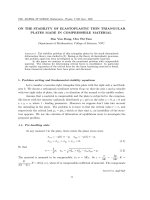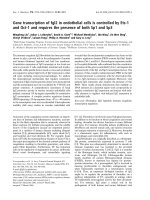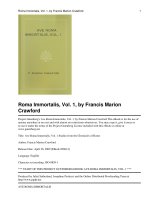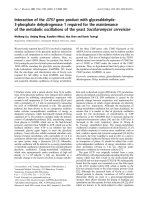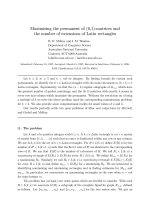report Common Law (Assignment 1) (Luật)
Bạn đang xem bản rút gọn của tài liệu. Xem và tải ngay bản đầy đủ của tài liệu tại đây (334.56 KB, 61 trang )
A REPORT OF COMMON LAW IN LAW OF CONTRACT
BANKING ACADEMY OF VIETNAM
Transmitted to:
Mr. Winslow
Prepared for
Lecturer:
Unit 5: Common law
Banking Academy, Hanoi
BTEC HND in Business (Finance)
Prepared by
Student ID:
Class:
No of words: 4488 (Excluding executive summary, introduction, conclusion, table
of contents, appendix and references)
Page | 4
EXECUTIVE SUMMARY
Law provides rules which can or cannot be done in personal lives and in business lives.
Contracts can appear in simple situations in daily life, but modern society operates by people and
companies exchanging goods and services and contracts are evidence for the human civilization
in their activities. The law of contract helps to give a structure to measure and evaluate them in
particular situations.
The law of contract is part of Private Law, so it is concerned with relationships between parties.
It helps us to decide what a valid contract is. In addition, the Law of Contract is also part of Civil
Law, so it is concerned with remedies. It helps us if the other party in a contract does not keep to
the agreement. The presence of contract law is a good tool for business activities in aiming
clarity and fairness and contributes to economic growth of each country as well. Therefore,
contract law increasingly plays a more and more important role in common law system from
which it can originally be traced. Moreover, most of transactions in society, no matter for
business purposes or common needs, relate to contract law. Based on equal, voluntary, agreeable
and responsible rules between two or more parties, contract law is identified to ensure the
freedom for participants and this is only limited by some exceptions to ensure public order or the
rights for the third party.
Taking the responsibilities of a legal executive of a solicitor firm, I made this report recording
claims accomplished with my recommendations to my client (Mr. Winslow) as well as my
interpreting in the related problems. During the process of analyzing details in the claims, I
applied all my knowledge and the theory about these terms to make the best suggestions for my
client. Furthermore, I would like my client to have understanding about their situation to make a
right decision and to know more about contract law and its importance in society. Besides, this
report is to provide an introduction to the law of contract with a particular focus on the formation
and operation of a business contract. In addition, the current report also contains the practical
application of standard form contract.
Based on the claims and legal issues relating to problems surrounding Mr. Winslow, I play a role
as a consultant about law especially contract law for him to deal with those problems and give
him useful recommendations. By all of my effort for investing time to study principles of
contract law and legal legislations to analyze these problems, I asserted the rights that my client
is worth getting and the strengths he was holding. In other words, I tried to find all means to
show evidence contradicting the claims Mr. Winslow require me to justify.
By making a detail about the problems and what I have done, this report could become a good
reference for me in the future. Moreover, it is also a proof which determines my level in this field
to be better and more confident to deal with similar problems. This is also a good experience for
me to improve my knowledge about the essential elements of a valid and legally binding contract
and its role in business context as well as the significance of specific terms in a business contract.
After dealing with these problems, I believe that I could be more flexible in considering claims
and applying contract law on my future work in term of economic field.
Page | 5
TABLE OF CONTENTS
Cover sheet.............................................................................................................................
Title page................................................................................................................................
Executive summary................................................................................................................
Table of contents....................................................................................................................
1. Introduction
1
4
5
6
1.1. Basic concept of Contract Law..................................................................................
9
1.2. The aims, purposes, scopes.........................................................................................
9
1.3. Sources of information................................................................................................
10
1.4. Limitation of weakness................................................................................................ 10
1a. TYPES OF BUSINESS AGREEMENT AND THE IMPORTANCE OF THE KEY
ELEMENTS IN A VALID CONTRACT
1a.1 EXPLANATION OF CONTRACT......................................................................
11
1a.1.1 DEFINITION OF CONTRACT.................................................................
11
1a.1.2 EXAMPLES FOR DIFFERENT TYPES OF CONTRACTS.................
11
1a.1.3 SITUATIONS TO ENTER INTO A CONTRACT.................................
12
1a.2 TYPES OF BUSINESS AGREEMENT...............................................................
13
1a.2.1 AGREEMENT......................................................................................…..
13
1a.2.2 EXAMPLES OF TYPES OF BUSINESS AGREEMENT......................
13
1a.3 THE IMPORTANCE OF KEY ELEMENTS IN A CONTRACT....................
14
1a.3.1 THE ESSENTIAL ELEMENTS TO FORM A CONTRACT...............
14
1a.3.2 EFFECT OF CONTRACT WHEN KEY ELEMENTS ARE
ABSENT......................................................................................................
14
1a.3.3 EFFECT ON AFFECTED PARTIES......................................................
15
1b. ANALYSIS OF THE SCENARIO FROM THE PERSPECTIVE OF THE LAW
OF CONTRACT AND APPLICATION OF OFFER AND ACCEPTANCE’S RULES
IN A GIVEN SCENARIO AND THE IMPACT OF NEW TECHNOLOGY
1b.1 ONLINE TRANSACTION....................................................................................
16
1b.2 DEFENCE AGAINST WINSLOW.......................................................................
16
1b.3 DEFENCE AGAINST CHARLENE....................................................................
17
Page | 6
1b.4 HOW TO PREVENT A SIMILAR INCIDENT FROM HAPPENING
AGAIN IN THE FUTURE..................................................................................
17
1c. ASSESSION FOR THE IMPORTANCE OF THE RULES OF INTENTION AND
CONSIDERATION OF THE PARTIES TO THE AGREEMENT
1c.1. The importance of intention..................................................................................
1c.2. The importance of consideration..........................................................................
1c.3. Mr. Winslow V Mrs. Winslow.............................................................................
1c.4. Legal intention for a room rental contract.........................................................
1c.5. Seeking to increase rent.......................................................................................
18
18
19
19
20
1d. THE IMPORTANCE OF THE CONTRACTING PARTIES HAVING THE
APPROPRIATE LEGAL CAPACITY TO ENTER A MINOR AND ANOTHER
PARTY
1d.1. Different groups of contracts between a minor and another party..................
20
1d.2. betting contract......................................................................................................
21
1d.3. Share contract........................................................................................................
22
1d.4 Fake gold chain contract.........................................................................................
23
2a. SPECIFIC CONTRACT TERMS WITH REFERENCE TO THEIR
IMPORTANCE AND IMPACT IF THESE TERMS ARE BOKEN
2a.1 Terms of existing contract.....................................................................................
23
2a.2 Restraint of trade and remedies............................................................................
24
2a.3 Exemption clause....................................................................................................
25
2b. STANDARD FORM CONTRACT
2b.1 Definition of standard form contract....................................................................
25
2b.2 Validity of the contract............................................................................................
25
2b.3 Express terms
Page | 7
2b.3.1 Conditions....................................................................................................
26
2b.3.2 Warranty......................................................................................................
26
2b.4 Implied terms.........................................................................................................
27
2b.5 Exemption clause...................................................................................................
27
2b.6 Main purpose rule.................................................................................................
28
2b.7 Fundamental breach..............................................................................................
28
2b.8. Unfair Contract Terms Act 1977.........................................................................
28
2c. EFFECT OF EXEMPTION CLAUSES IN ATTEMPTING TO EXCLUDE
CONTRACTUAL LIABILITY
2c.1. Exclusion clause.......................................................................................................
29
2c.2 Exclusion clause 1: Newport Service can accept no responsibility for any
damage caused as a consequence of repairs carried out on these
premises....................................................................................................................
29
2c.3 Exclusion clause 2: The exclusion clause of the Newport which claims ‘these
premises are dangerous. Clients enter these premises at their own risk and
Newport Service accepts no responsibility for any damage or injury
sustain......................................................................................................................
CONCLUSION.....................................................................................................................
REFERENCE........................................................................................................................
APPENDICES.........................................................................................................................
31
33
34
37
1. INTRODUCTION
1.1. Basic concept of Contract Law
By the different overview from different aspects, the basic concepts of contract law are
known variously. As far as the basic requirements to make a contract are concerned, the
Page | 8
basic concepts include an agreement, consideration, intention to create legal relation,
certainty as the terms of the agreement and capacity to contract. However, they are also
classified into five popular areas involved in formal contracts, simple contracts, apparent
simple contracts (intention, agreement and consideration), elements of simple contracts
which may affect validity (capacity, certainty and legality) and simple contracts-forms.
No matter how contract law is interpreted into the basic concepts, it is thoroughly
examined with the aid of real life cases, the rights and obligations that contracts create
and which the law will enforce.
1.2. The aims, purposes, scopes
This report mentions to the principles that makes a valid contract through providing an
introduction to the fundamental facts that anyone should know about the Law of
Contract. My purpose in the process of writing the current report are to record my
knowledge and understanding of the main principles of the law of contract. Besides, it
also supports me with a sound foundation for the study of other subjects based upon or
involving the law of contract. Based on my experience in recommending my client, I
could develop skills of legal analysis and problem solving. Therefore, this is a good start
for my effort for my further future.
1.3. Sources of information
To support my analysis and evaluations for particular situations, I collected information
from the Internet which contains various sources of information from different
Page | 9
viewpoints. Moreover, I found data from the course book Common Law I (Mandatory
Unit 5) to support my explanations. Furthermore, in order to make my arguments more
persuadable, I made use of books from the library of Banking Academy. Above all, I used
all of my experience and understanding about this field to solve problems and record
them into this report.
1.4. Limitation of weakness
The current report is a result of my careful and hard effort but it cannot avoid limitations
during the process making this report. Because of word account that only allows no more
than 3000 words, I have trouble in going in details with my explanations and analysis.
The other difficulty that I had to deal with is my weakness in solving the claims to give
the best advice for the client. I think that in the next time I will be more confident and
cleverer to make a good impression on the clients and hopefully I could get useful
suggestions from you for my greater improvement.
1a. TYPES OF BUSINESS AGREEMENT AND THE IMPORTANCE OF THE KEY
ELEMENTS IN A VALID CONTRACT
Page | 10
1a.1 EXPLANATION OF CONTRACT
1a.1.1 DEFINITION OF CONTRACT
According to the American Law Institute "a contract is a promise or a set of
promises for the breach of which the law gives a remedy or the performance of
which the law in some way recognizes as a duty”.
1a.1.2 EXAMPLES FOR DIFFERENT TYPES OF CONTRACTS
1
TYPES OF CONTRACTS
Bilateral contract involves an exchange of
CASE EXAMPLES
Thornton v Shoe Lane Parking Ltd
promises- a promise for a promise.
(1971) (Appendix 1a.1.1a, p37)
2
3
Unilateral contract involves an
Lefkowitz v Great Minneapolis Surplus
exchange of an act for a promise
Store (1957) (Appendix 1a.1.1b, p37)
Express contract is one in which the terms
are expressed verbally, either orally or in
Bovell Vs. Voorheis (1879) (Appendix
1a.1.1c, p38)
writing.
4
Implied contracts is one in which the
Clarke v Dunraven (1897) (Appendix
circumstances imply that parties have
1a.1.1d, p39)
reached an agreement.
5
Promissory estoppel : a party can rely on
Central London Property Trust Ltd V
a promise made by another party despite
High Trees House Ltd [1947]
the nonexistence of a formal , or even
(appendix 1a.1.1e, p40)
Page | 11
6
implied contract.
Quasi contracts are obligations imposed
by law to avoid injustice.
7
Simple contract is any contract other than
8
9
a formal contract
Specialty contract is under seal contract
Standard form the standard document
Callano v. Oakwood Park Homes Corp
(1966) (appendix 1a.1.1f, p41)
Labor contract ( appendix 1a.1.1i, p41)
prepared by many large organizations and
setting out the terms on which they
contract with their customers.
1a.1.3 SITUATIONS TO ENTER INTO A CONTRACT WITH SOMEONE
You enter into a contract with someone when you open an account in a bank,
when you hire a flat and when you borrow money from someone.
1a.2 TYPES OF BUSINESS AGREEMENT
1a.2.1 AGREEMENT
Page | 12
Agreement exists when an offeror makes an offer to an offeree that is accepted
by the offeree. Agreement which is the first requirement for a valid contract
contains an ‘offer’ and an ‘acceptance’.
Offer is a definite promise to be bound on specific terms and acceptance is the
unqualified agreement to the terms of the offeror. Both offer and acceptance are
important because they are a useful technique for the courts in assessing at what
point an agreement should be binding. If there is missing one of them, the
agreement does not exist and then the contract is invalid.
Applying to the case to open an account in a bank, you make an agreement with
the bank about amount of the loan, repayment terms, and insurance against nonpayment and so on.
1a.2.2 EXAMPLES OF TYPES OF BUSINESS AGREEMENT
There are many kinds of business agreement like employment contract,
franchising contract or renting a property. Taking a case example for renting a
property contract (appendix 1a.2.2, p…..), the offeror is San Miguel House and
renter is the offeree for the terms of security deposit, general policies, care and
maintenance and so on.
1a.3 THE IMPORTANCE OF KEY ELEMENTS IN A CONTRACT
1a.3.1 THE ESSENTIAL ELEMENTS TO FORM A CONTRACT
Page | 13
Agreement, consideration and intention to create legal relations are three
essential elements for forming a contract. Following that, agreement is formed
when the offer is accepted and consideration which is an exchange of value
must be real, legal and inadequate. Intention to create legal relations means
the parties entering into a contract must have an intention to create a legal
relationship.
Besides, there are validity factors affecting on making a binding contracts. The
first one is form which states a contract may be in any form (written or oral)
and then a genuine consent means the validity of a contract can be affected if a
person has been mislead into a contract. Capacity says the parties must be
legally capable of entering into a contract and the content of a contract must be
complete and precise in its terms and legality means the purpose of the
agreement must not be illegal or contrary to public policies.
1a.3.2 EFFECT OF CONTRACT WHEN KEY ELEMENTS ARE ABSENT
In order to be valid and enforceable by the law, a contract must contain these
essential elements; otherwise there is no contract, but the legal effect of
contracts falls into 4 categories: valid, void, voidable or unenforceable
contracts.
1a.3.3 EFFECT ON AFFECTED PARTIES
Page | 14
Vitiating factors which make a contract void or voidable are mistake,
misrepresentation, duress, undue influence and public policy. Following that,
with a void contract, there is no legal effect at any time: neither party can
obtain rights or obligations under it, while a voidable contract is valid unless
and until it is avoided. Besides, an unenforceable contract is one which is
valid but which cannot be enforced by either of the parties should something go
wrong.
By giving case examples to support the explanation of the different types of
business agreement and the importance of the key elements required for the
formation of a valid contract, this part provides a basic understanding about
business contract.
1b. ANALYSIS OF THE SCENARIO FROM THE PERSPECTIVE OF THE LAW OF
CONTRACT AND APPLICATION OF OFFER AND ACCEPTANCE’S RULES IN A
GIVEN SCENARIO AND THE IMPACT OF NEW TECHNOLOGY
1b.1 ONLINE TRANSACTION
According to formation and validity of contracts under s.11 of the Electronic
Transaction Act Cap 88, an offer and the acceptance may be expressed by means of
Page | 15
electronic communications. Case example: Chwee Kin Keong v Digilandmall. Pte Ltd
(appendix 1b.1, p….).
Also, considered as the effectiveness of contract between parties on an electronic
communication, a declaration of intent or other statement shall not be denied legal
effect, validity or enforceability.
Besides, the webside that contains the details and the prices of the goods is confirmed
as an invitation to treat based on s.14 Invitation to make offer under the Electronic
Transactions Act, Caps 88.
Based on the case scenario, there was an error in electronic communications and
following that selling Iphone4 of M5 was an invitation to treat. Nevertheless, Winslow
offered and M5 got benefits from that which is considered as an acceptance, so between
Winslow and M5, there was an agreement that made the contract binding.
1b.2 DEFENCE AGAINST WINSLOW
If M5 failed to deliver iphones to Winslow, he would breach the contract because
there was a valid contract between M5 and Winslow. However, being an owner of a
handphone shop, he knows M5’s mistake in the price (only $ 588) which should have
been $ 1,180. Therefore, Winslow violated the contract by taking advantage from
M5’s mistake.
Page | 16
The iphone price was changed due to M5’s mistake; they did not know this changing.
So according to the unilateral mistake rule, the contract is void and is not bound of
this online transaction. Therefore, M5 does not have to deliver iphones to Winslow.
Case example: Taylor v Johnson (1983) (appendix 1b.2, p…..)
1b.3 DEFENCE AGAINST CHARLENE
M5 will breach the contract if they do not deliver the set of handphone to Charlene,
the university student. Following that M5 defense is weaker than Charlene. The
reason is that there is a valid contract between M5 and Charlene. Moreover, M5 does
not know about their mistake for the iphone price and Charlene, a university student
also has no idea about this mistake. Therefore, there is a common mistake in this case
that keeps the contract valid and M5 has to buy the iphone to Charlene. Case
example: Leaf v International Galleries (1950) (appendix 1b.3, p.....)
1b.4 HOW TO PREVENT A SIMILAR INCIDENT FROM HAPPENING AGAIN
IN THE FUTURE
A counter offer is an offer made in response to an original offer to give a new term
during negotiations for a final contract. The reason is that the automated reply
represents M5 identifies the order and confirms the contract about the quantity and
price. Therefore, M5 can make use of counter offer rule to terminate the original offer
and to prevent similar situations. Instead of the automated reply that claims successful
Page | 17
transaction, M5 should reply that transaction is in processing and it depends on
available goods condition and others. With this method, M5 could void mistake by
using available good condition to reply their customers after they already confirm the
transaction.
1c. ASSESSION FOR THE IMPORTANCE OF THE RULES OF INTENTION AND
CONSIDERATION OF THE PARTIES TO THE AGREEMENT
1c.1. The importance of intention
The requirement of intention to create legal relations in contract law is to sift out the
cases and to identify a binding contract as an essential element of a contract’s
formation. In order to determine which agreements are legally binding and have an
intention to create legal relations, the law draws a distinction between domestic
arrangements and commercial agreements.
1c.2. The importance of consideration
The essence of a valid contract is also the idea of the ‘exchange of value’ between
parties when each side receives something from the other. Therefore, the rule of
consideration is that it must be sufficient, must not be past but need not be adequate,
because past consideration means there is no contract. Based on that, consideration is
divided into two kinds including executory and executed consideration. When there is
an exchange of promise to perform acts in the future, consideration is called ‘executory’
and when the act performance is completed, it is ‘executed’ consideration.
Page | 18
1c.3. Mr. Winslow V Mrs. Winslow
According to Domestic Arrangements between husband and wife, in Winslow’s case,
there was no intention to create legal relations. Case example: Balfour v
Balfour [1919] (appendix 1c.3.1, p…..)
However, as far as the property matters are concerned, between Mr. and Mrs. Winslow
there is an existence of a legal intention, so there is a valid contract. Case example :
Merritt v Merritt [1970] (appendix 1c.3.2, p…..). In short, there is a valid contract
between Mr. and Mrs. Winslow.
1c.4. Legal intention for a room rental contract
It is presumed in commercial agreement that there is a intention to create legal relation
by both parties. Case example: Edwards v Skyways [1964] (appendix 1c.4, p……)
In the given case, between Mrs. Winslow and Coco, there was a legal sufficiency of
consideration because Mrs. Winslow got benefit renting out the room to Coco to keep
up her monthly payment to the bank. Besides, there was also an adequacy of
consideration which was proven by the agreement of Coco with the rent of £150 per
calendar month. Therefore, a binding contract was created.
After Coco had voluntarily installed new air con and changed the wardrobe, Mrs.
Winslow promised to reduce the rent by £50 per month and at this time the promise was
made after performance, so past consideration existed. Based on the rule, there was no
consideration in the case that means Mrs. Winslow’s promise will not be enforced at
law. Case example: Roscorla v Thomas (1842) (Appendix 1c.4, p........) .... sach Trang
p 303
Page | 19
1c.5. Seeking to increase rent
In existing contract, Coco had to pay £150 per month for rent to Mrs. Winslow, but
now Mrs. Winslow is seeking to increase rent to £200 per month when there is an
existing contract. According to the unsupported fresh consideration rule, increasing
to £200 is a further promise which makes no contract arise. Hence, Coco does not have
to pay extra money for the rent.
Besides, based on mirror image rule which says acceptance must match exactly with
the offer to make an agreement, while there was a modification in this case at the time
the contract is existing. For that reason, Mrs. Winslow was not entitled to increase or
decrease the rent and also if Coco does not pay the exact amount of rent in existing
contract, she could be sued by Mrs. Winslow.
1d. THE IMPORTANCE OF THE CONTRACTING PARTIES HAVING THE
APPROPRIATE LEGAL CAPACITY TO ENTER A MINOR AND ANOTHER PARTY
1d.1. Different groups of contracts between a minor and another party
Three different main groups of contracts between a minor and another party include
valid contract, voidable contract and unenforceable contract.
The only contracts which are binding on a minor are contracts for supply of necessary
goods and services (case example: Chapple v Cooper (1844) (appendix 1d.1, p….))
and service contract for minor’s benefit (case example: Roberts v Gray (1913)
Page | 20
(appendix 1d.1, p…)). However, if the minor sets himself up in business, he will not
be bound by his trading contracts, even though they are for his benefit.
The contracts with minors could be voidable if they relate to leases of land,
partnerships and purchase of shares. At these situations, these contract are valid when
they are made, but can be terminated by a minor at any time before becoming 18.
Case example: Corpe v Overton (1833) (appendix 1d.1, p……….)
All other contracts entered into by a minor are described as unenforceable, which
means the minor is not bound but the other party is bound.
1d.2 Betting contract
Between Benny and bookmaker, there is a void contract and applying Act No.7, 2004
National Gambling Act, 2004 (s12), a minor must not engage in, conduct or make
available gambling activity. Applying rule of gambling act, all the betting with minor
is void. Case example: Mercantile Union v Ball (1937) (appendix 1d.2.1, p.....).
Under common law and gambling act 2004, it is a void contract for Benny to enter
the William Hill Betting PLC and placed a bet. That means the contract can be
enforced if Benny ratifies it within a reasonable time after turning 18. Based on that,
Benny will receive nothing even his capital from this betting, because of the void
contract between Benny and the bookmaker.
1d.3 Shares contract
Page | 21
Purchasing share is a legal activity for Benny and there is a difference between
purchasing share which involves a permanent or continuous interest, while gambling
involves intermediate benefits or risks. Based on that, it is a voidable contract for
Benny and unenforceable contract for the stockbrokers.
Applying the rule of voidable contract, the contract is binding on Benny until he
decides to reject it before becoming 18. In other words, if Benny repudiates the
contract at presence, he will receive nothing of value in return. Case example:
Steinberg v Scala (1923) (appendix 1d.3, p..)
Applying the rule of unenforceable contract, the stockbrokers are bound at law but
Benny was not. Therefore, the stockbrokers cannot force Benny to pay up for the
price of share, on the other hand Benny is able to sue the stockbroker on the contract
for the lack of payment it he sells the shares. Based on that, it is likely for Benny to
enforce the contract.
Because of voidable contract on Benny and unenforceable contract on stockbrokers,
Benny was not bound at law but he was entitled to sue stockbrokers to get his interest
for the shares if he really pays money for the share. Actually Benny just phoned to
stockbrokers to take in advance for the share, so he will not have rights to sue the
stockbrokers.
1d.4 Fake gold chain contract
Page | 22
According to the caveat emptor Latin for "let the buyer beware." The consumers are
at your own risk and should personally examine and test for obvious defects and
imperfections of products they buy. Applying this rule to the case, Thomas has
responsibilities to check the quality of the gold chain. Moreover, Benny intentionally
provides Thomas with fake gold chain which is misrepresentation. Thomas still has to
pay Benny with this fake golden chain. However, he could sue Benny if he could
prove that Benny continues buying fake golden chain. In this first time, Benny is not
bound at law, but in the other time, he would be responsible for this trade.
2a. SPECIFIC CONTRACT TERMS WITH REFERENCE TO THEIR
IMPORTANCE AND IMPACT OF THESE TERMS
2a.1 Terms of existing contract
The terms of a contract describe the duty and obligations that each party assumes under
their agreement. In the case of Winslow and Cindy, there are two existing terms and
both of them are express term. Express term is a clear stipulation in the contract and it
is classified as conditions- terms that are crucial to the operation of a contract; or
warranties – terms that are less important. While implied terms may be divided by:
custom, the Courts or the Statute.
For these reasons, contracts that contain restraint of trade clauses will be void unless
they are reasonable and in the public interest. Following that, the court will examine the
clause in regard to the type of trade or business. Besides, remedies are the legal means
of correcting loss and damage.
Page | 23
2a.2 Restraint of trade and remedies
There is a possibility to have exclusive agreement to give attention to restraint trade in
order to protect Cindy’s interest. Case example. Nordenfelt v Maxim Nordenfelt Guns
and Ammunition Co (1894) (appendix 2a.2, p...)
The restraints of trade will be valid if they are reasonable. According to the test of
reasonableness (s.11), restraint clause in a contract is accepted if it involves a
consideration of the interests of the parties. Besides, the court will consider whether
customers could have been entered into similar contract with another party without
agreeing the first claim. If Winslow terminates the contract, Cindy will have to suffer
from lost of sale which leads to loss of profits. Therefore, with the recovery action as
remedy, Cindy use this clause.
To make it reasonable and fair for Winslow to meet the clause 1, Winslow needs to get
benefits in price or quality of service. However, Winslow does not receive any benefits
from the agreement with this clause in which Cindy does not undertake as to quality of
the materials used and good workmanship.
Because of these reasons, the restraint of trade is unreasonable which leads to be void
in the contract and it is unlikely to be valid, so Cindy has no rights to prevent Winslow
from buying elsewhere.
2a.3 Exemption clause
Page | 24
The term for exemption clause is the express term which is condition. Applying sale of
Goods Act 1979, s.13 (1), s.14(2) and s.14(3), the contract for sale of goods cannot
exclude liability for breach of condition relating to quality, while the second of clause
claims in no undertaken the liability for service quality and this is unreasonable term.
Also applying UTCA act, Avoidance of liability for breach of contract s.3(a), Cindy fails
to perform the condition term in the contract which does not allow Cindy to restrict her
liability for her own breach of condition.
Based on the analysis, Winslow did not breach the contract to go on another contract
because the exemption clauses are unlikely to be successful and Cindy has to suffer from
all loss.
2b. Standard form contract (labor contract)
2b.1 Definition of standard form contract
Standard form contract is the standard document prepared by many large organizations
and setting out the terms on which they contract with their customers.
2b.2 The validity of labor contract
This is a valid contract between the offeror_ Van Laack Asia Co., Ltd whose
representative is Ms. Kim Thu Huong and the offeree: Truong Minh Tuyen. The
contract is formed with the agreement between the employee and the employe. The
offer is to provide a job and the acceptance is to get the job with the sign of the
contract.
2b.3 Express term
Page | 25
In the eye of common law, express term is divided into two categories: conditions and
warranties
2b.3.1 Conditions
Condition is defined as ‘a term which is vital to the contract, going to the root of
the contract’. The condition terms are performed in article 3.2 and 4.2 of the
labor contract in which the employee has to fulfill the job undertaken in the
contract as well as to strictly follow and respect the term of and commitment in
the Labor contract. These conditions directly affect the main purpose of the
agreement. Following that, the condition terms limit the scope of employees in
which it claims the requirements for employees.
Breach of conditions
•
Assuming that employer cannot fulfill his job undertaken of this
contract, such as fail to comply production and business orders,
cause a damage or loss properties due to his carelessness, negligence
or stolen.
In this case, the company’s Director is able to terminate the contract
•
with TRUONG MINH TUYEN and hire a new employee.
Another assumption is whether if TUYEN terminated the contract
such as violate the regulations and rule of the company, or his health
and ability cannot meet the work’s requirement, the company can
claim for that damages and has the right to put an end to the contract.
2b.3.2. Warranty
Warranty is a term that is subsidiary to the main purpose of the agreement. In
this contract, warranty appears to be uniform, salary, bonus, training. However,
all the information in these terms is unclear in which the bonus is according to
the training schedule.
Page | 26
Breach of warranty
•
In an assumption of the company faces a loss in their earnings so it
cannot pay employee enough salary on time (for example, the
company only pays 50 USD instead of 53.50 USD). At that time,
TUYEN only has the right to claim for his damages caused by the
company, such as asks for compensation. He does not have the right
•
to terminate the contract
In the case that employee has a health problem and he needs the
health insurance from the company, if the company refuses to pay
insurance for TUYEN, he can claim for the financial damages
caused by the company. But he cannot breach the contract because of
this insurance problem.
2b.4. Implied terms
Terms in the contract are implied by statue: labor law and regulations. In Right
and benefits of employee, “Time of rest: According to the Company’s Labor
Regulation and current labor regulations.” Applying the Working Time
Regulations 1998, regulation 10, a worker is entitled to a rest period of 11
consecutive hours rest in each 24 hour period during which he works for his
employer.
2b.5. Exemption clause
Exemption clause: “Compensate to the Company all training expenses and/or
monetary commitment mentioned in the Labor contract and/or in labor
regulations of the Company in the case the Employee intentionally terminates
the Labor contract without approval of the director of the Company.” According
to The contra proferentem rule, the term is vague because it’s hard to define
Page | 27
whether the employee intentionally or not. The court has to consider the others
are subject to a test of reasonableness under UCTA 1977 rules (s.11) to make
decision.
2b.6. Main purpose rule
The main purpose of the contract is to hire employee. In the Obligation of
Employee section, the term “employee shall compensate for damage or loss
properties incurred by the Company due to carelessness, negligence or stolen” is
inconsistent with the purpose of the contract. Applying main purpose rule, the
court can strike out this exemption clause.
2b.7. Fundamental breach
Fundamental breach occurs when there is a failure to perform the contract. In
this contract, the job requirements are not clear, which lead to vague offer and it
is difficult for the seller_ employees to meet the particular requirements of the
company. This can be easy to get fundamental breach of the contract.
2b.8. Unfair Contract Terms Act 1977
UTCA 1977 uses two techniques for controlling exclusion clauses: some types
of clauses are void and test of reasonableness.
2c. EFFECT OF EXEMPTION CLAUSES IN ATTEMPTING TO EXCLUDE
CONTRACTUAL LIABILITY
Page | 28
